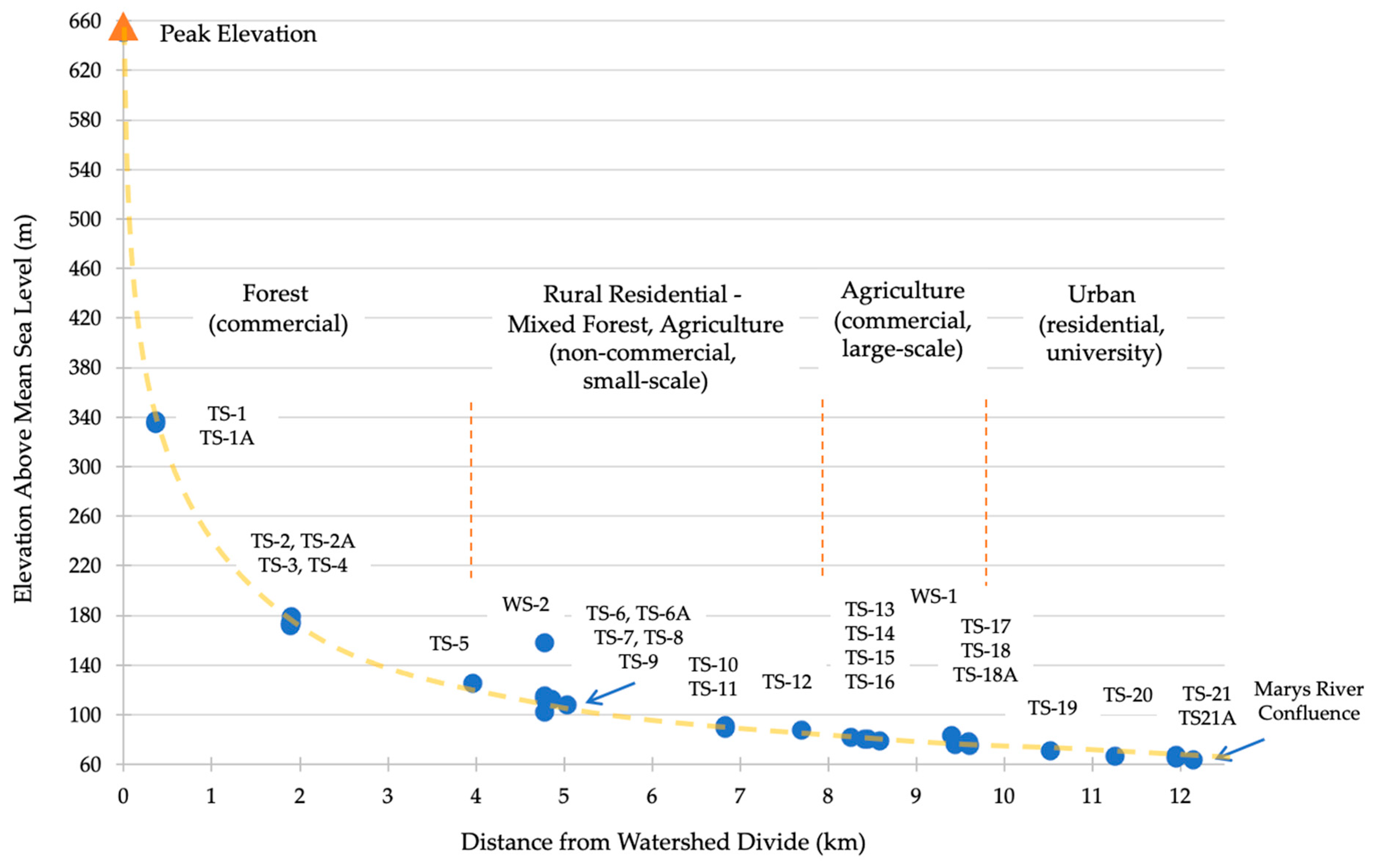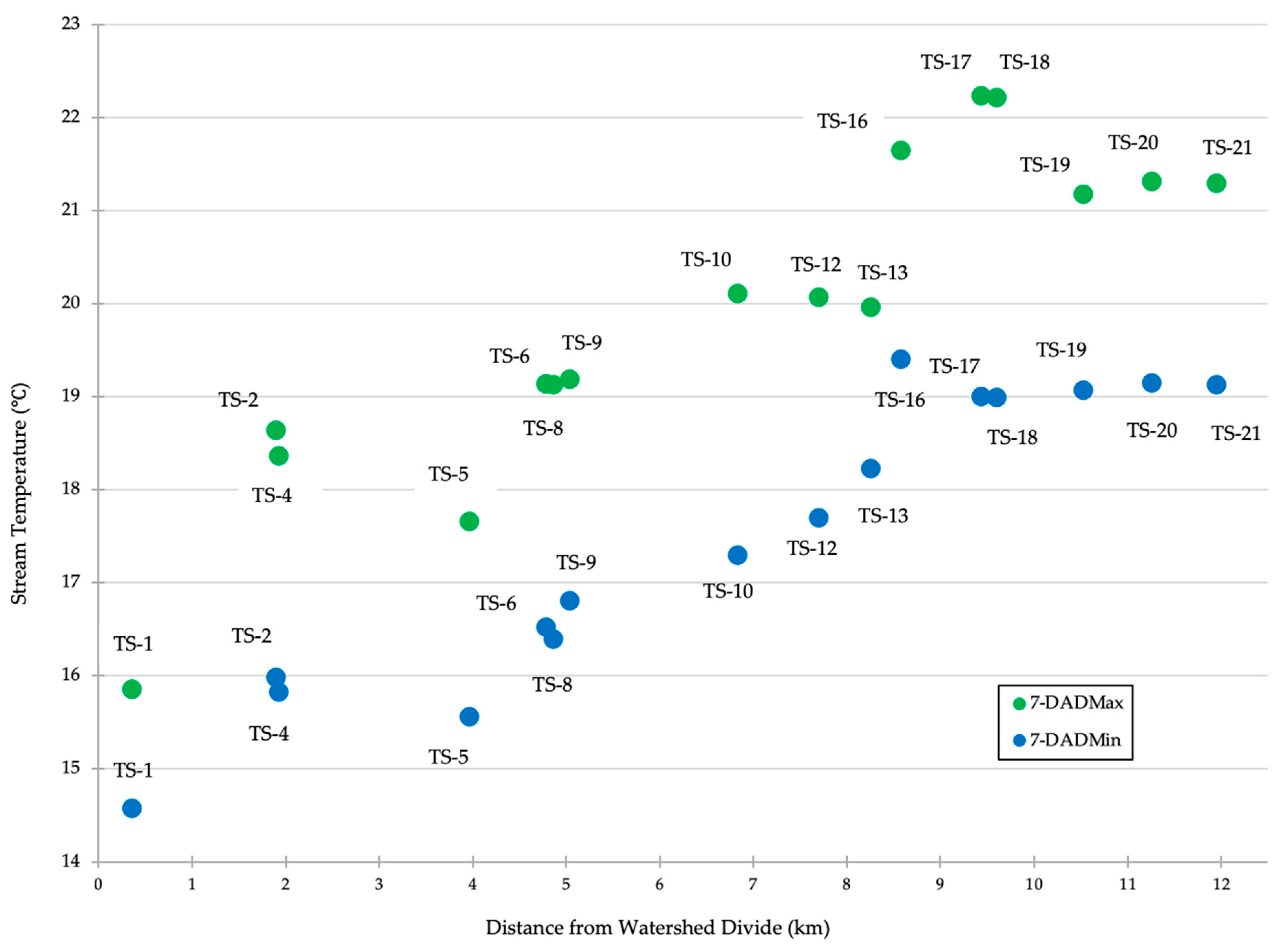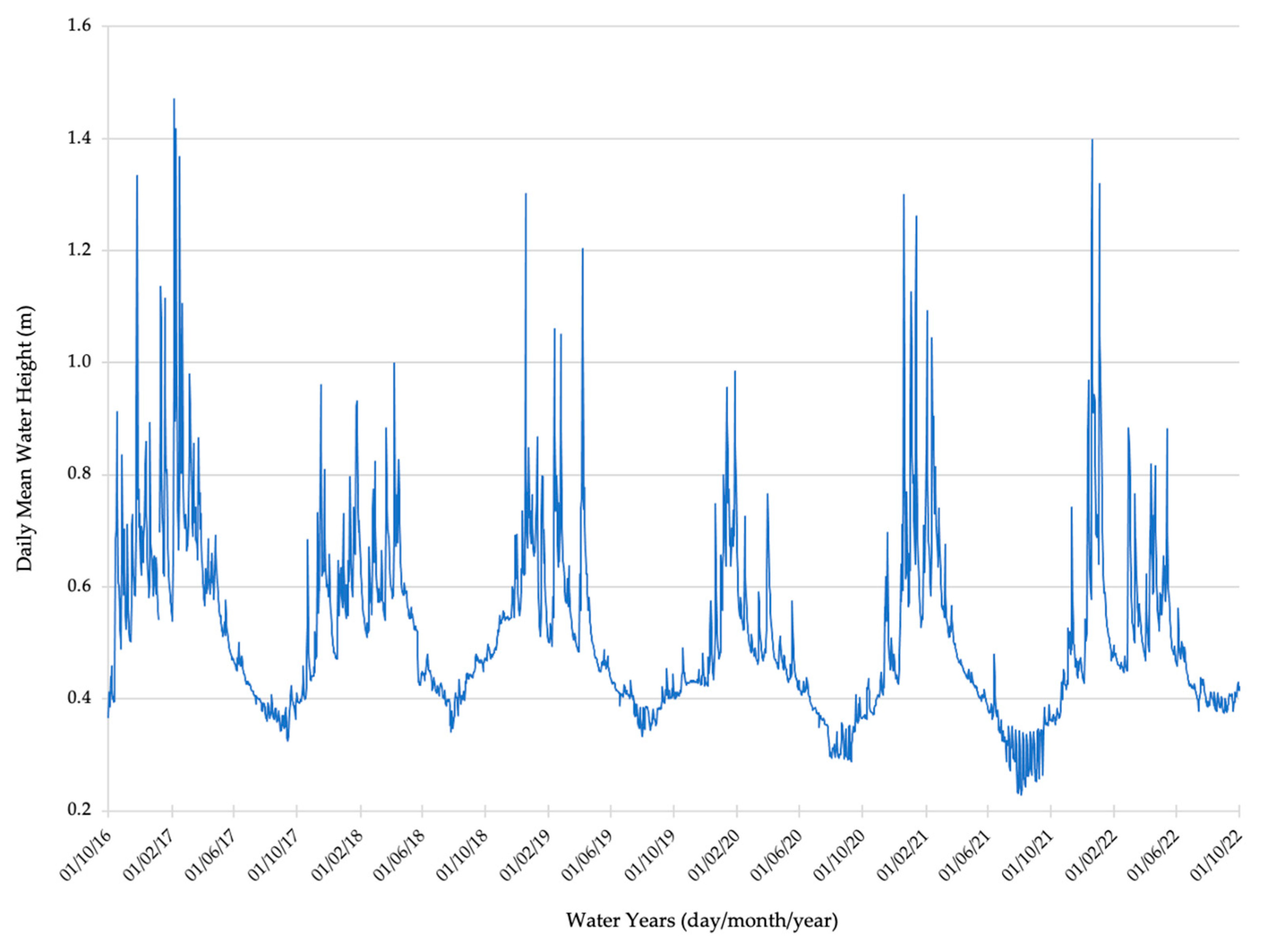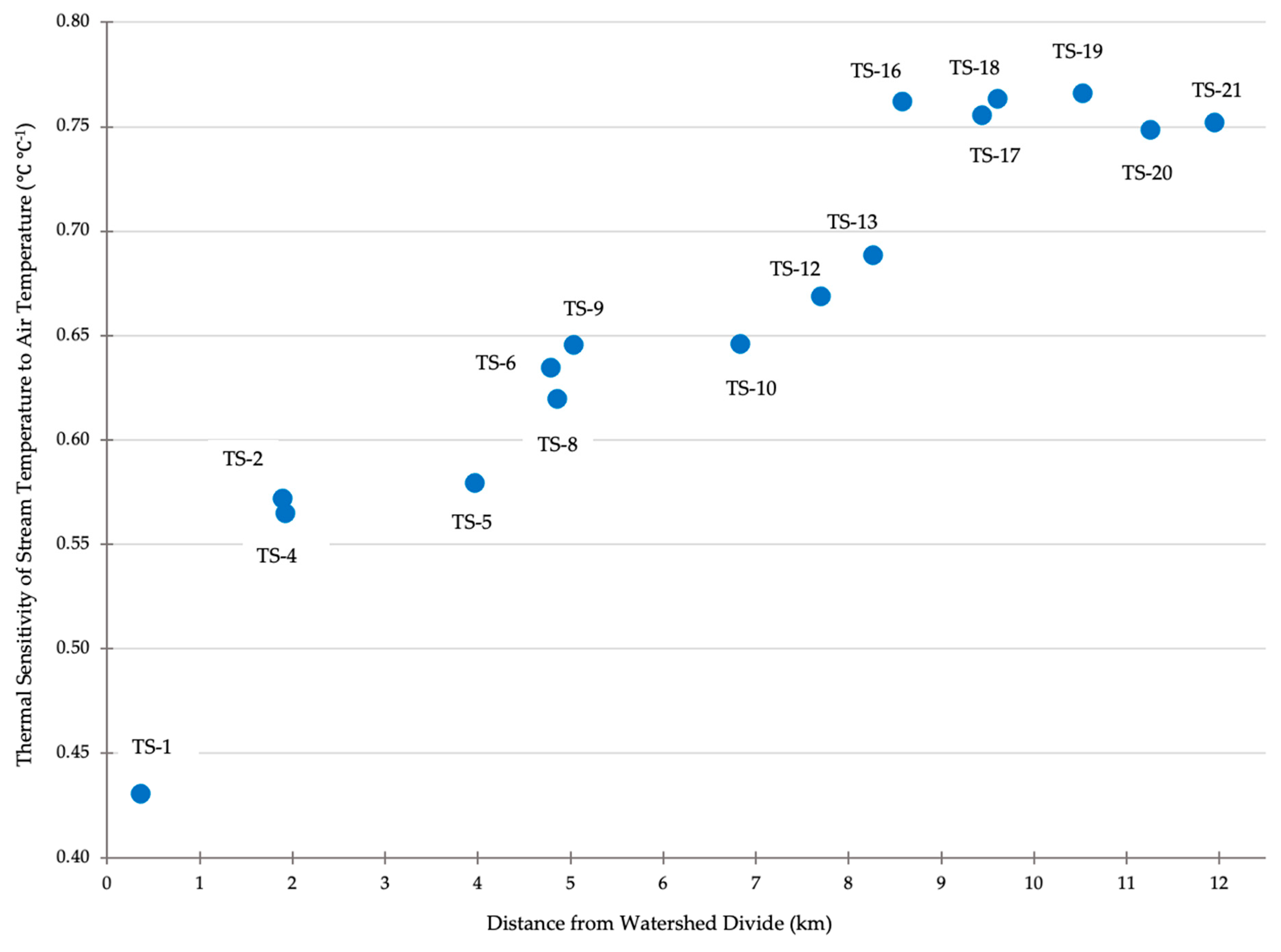Assessing Stream Temperature Interactions with Physical and Environmental Variables Along the Longitudinal Profile of a First- to Fourth-Order Perennial Stream in a Multi-Land Use Watershed in Western Oregon, USA
Abstract
1. Introduction
2. Materials and Methods
2.1. Study Site
2.2. Temperature, Weather, and Stream Stage-Flow Monitoring
2.3. Stream and Riparian Characteristics
2.4. Data Analysis
3. Results
3.1. Stream Temperature Seasonal Variability and Trend Analysis
3.2. Stream Temperature, Environment, and Landscape Feature Relationships
3.2.1. Water Height and Streamflow
3.2.2. Stream Temperature Variability Along the Longitudinal Profile
3.2.3. Stream-Riparian Features and Solar Radiation Correlations to Stream Temperature
4. Discussion
Author Contributions
Funding
Data Availability Statement
Conflicts of Interest
Appendix A
| 7-DADMax | 7-DADMin | 7-DADMax - | ||||
|---|---|---|---|---|---|---|
| Station | Mean (SE) | Range | Mean (SE) | Range | 7-DADMin | n |
| TS-1 | 15.85 (0.77) | 15.08–16.62 | 14.58 (0.70) | 13.88–15.28 | 1.27 | 2 |
| TS-2 | 18.63 (0.32) | 17.51–19.43 | 15.98 (0.35) | 15.04–16.96 | 2.66 | 6 |
| TS-4 | 18.37 (0.25) | 17.46–19.09 | 15.83 (0.31) | 15.03–16.69 | 2.54 | 6 |
| TS-5 | 17.66 (0.35) | 17.07–18.27 | 15.55 (0.05) | 15.50–15.66 | 2.11 | 3 |
| TS-6 | 19.14 (0.41) | 18.00–20.88 | 16.52 (0.40) | 15.70–18.09 | 2.62 | 6 |
| TS-8 | 19.13 (0.42) | 17.94–20.51 | 16.40 (0.45) | 15.39–17.73 | 2.73 | 5 |
| TS-9 | 19.19 (0.50) | 17.97–20.15 | 16.81 (0.47) | 15.63–17.66 | 2.39 | 3 |
| TS-10 | 20.11 (0.27) | 20.05–20.93 | 17.29 (0.41) | 16.37–18.75 | 2.82 | 5 |
| TS-12 | 20.07 (0.35) | 19.17–21.56 | 17.69 (0.33) | 16.88–19.19 | 2.38 | 6 |
| TS-13 | 19.96 (0.51) | 18.58–21.49 | 18.22 (0.38) | 17.41–19.53 | 1.73 | 5 |
| TS-16 | 21.65 (NA) | 21.65 | 19.40 (NA) | 19.4 | 2.25 | 1 |
| TS-17 | 22.24 (0.48) | 20.90–23.11 | 19.01 (0.53) | 18.03–20.33 | 3.24 | 4 |
| TS-18 | 22.22 (0.25) | 21.79–22.80 | 18.99 (0.37) | 18.19–19.89 | 3.23 | 5 |
| TS-19 | 21.18 (0.45) | 19.93–21.95 | 19.07 (0.49) | 18.06–21.95 | 2.12 | 4 |
| TS-20 | 21.32 (0.35) | 20.08–22.31 | 19.15 (0.31) | 18.32–20.28 | 2.17 | 6 |
| TS-21 | 21.30 (0.29) | 20.44–21.64 | 19.12 (0.36) | 18.06–19.55 | 2.18 | 4 |
| TS-15* | 19.84 (0.77) | 18.71–21.97 | 17.88 (0.28) | 17.29–18.46 | 1.96 | 4 |
| Tributaries | ||||||
| TS-3 | 16.93 (0.46) | 15.64–18.27 | 15.06 (0.37) | 14.05–16.29 | 1.87 | 5 |
| TS-7 | 18.56 (0.33) | 17.71–19.96 | 15.75 (0.34) | 14.94–17.03 | 2.81 | 6 |
| TS-11 | 21.13 (0.72) | 18.73–23.08 | 18.52 (0.33) | 17.11–19.43 | 2.61 | 6 |
| TS-14 | 20.92 (0.58) | 19.47–22.62 | 18.69 (0.39) | 17.91–19.73 | 2.23 | 5 |
| 7-DADMin | 7-DADMax | 7-DADMax - | ||||
|---|---|---|---|---|---|---|
| Station | Mean (SE) | Range | Mean (SE) | Range | 7-DADMin | n |
| TS-1 | 5.44 (0.58) | 4.82–6.60 | 6.41 (0.54) | 5.65–7.46 | 0.97 | 3 |
| TS-2 | 3.99 (0.51) | 2.96–5.78 | 5.34 (0.47) | 4.27–6.98 | 1.35 | 5 |
| TS-4 | 4.15 (0.57) | 2.96–5.63 | 5.33 (0.55) | 4.27–6.81 | 1.19 | 4 |
| TS-5 | 4.27 (0.63) | 3.59–5.52 | 5.54 (0.61) | 4.75–6.74 | 1.27 | 3 |
| TS-6 | 3.29 (0.18) | 2.93–3.46 | 4.72 (0.30) | 4.15–5.47 | 1.43 | 4 |
| TS-8 | 3.86 (0.45) | 2.50–5.57 | 5.22 (0.46) | 3.79–6.90 | 1.36 | 5 |
| TS-9 | 4.06 (0.61) | 3.26–5.25 | 5.56 (0.50) | 4.99–6.56 | 1.51 | 3 |
| TS-10 | 3.75 (0.46) | 2.94–5.00 | 4.96 (0.53) | 3.79–6.33 | 1.21 | 4 |
| TS-12 | 3.36 (0.45) | 2.22–5.00 | 4.66 (0.47) | 3.42–6.31 | 1.30 | 5 |
| TS-13 | 3.22 (0.64) | 1.20–5.17 | 4.56 (0.62) | 2.61–6.38 | 1.34 | 5 |
| TS-16 | 3.39 (NA) | 3.39 | 5.53 (NA) | 5.53 | 2.14 | 1 |
| TS-17 | 3.23 (0.47) | 1.85–4.70 | 4.42 (0.50) | 2.94–5.94 | 1.19 | 5 |
| TS-18 | 3.74 (0.38) | 3.24–4.86 | 4.87 (0.42) | 4.21–6.10 | 1.14 | 5 |
| TS-19 | 3.29 (0.23) | 2.84–3.59 | 4.70 (0.42) | 3.92–5.35 | 1.41 | 3 |
| TS-20 | 2.66 (0.39) | 1.99–3.35 | 3.78 (0.48) | 2.98–4.92 | 1.13 | 3 |
| TS-21 | 2.74 (0.50) | 1.86–3.59 | 3.89 (0.57) | 2.95–4.92 | 1.15 | 3 |
| TS-15* | 2.76 (1.09) | 1.15–4.83 | 3.66 (1.24) | 1.92–6.07 | 0.91 | 3 |
| Tributaries | ||||||
| TS-3 | 4.00 (0.63) | 2.30–6.13 | 5.07 (0.67) | 3.00–7.04 | 1.06 | 5 |
| TS-7 | 3.53 (0.17) | 2.95–3.96 | 5.00 (0.17) | 4.37–5.32 | 1.47 | 4 |
| TS-11 | 2.48 (0.68) | 0.95–4.01 | 3.51 (0.80) | 1.73–5.35 | 1.03 | 4 |
| TS-14 | 3.07 (0.26) | 2.25–4.12 | 4.25 (0.24) | 3.66–5.33 | 1.18 | 6 |
References
- Bonacina, L.; Fasano, F.; Mezzanotte, V.; Fornaroli, R. Effects of Water Temperature on Freshwater Macroinvertebrates: A Systematic Review. Biol. Rev. 2023, 98, 191–221. [Google Scholar] [CrossRef]
- Caissie, D. The Thermal Regime of Rivers: A Review. Freshw. Biol. 2006, 51, 1389–1406. [Google Scholar] [CrossRef]
- Allan, J.D.; Castillo, M.M. Stream Ecology; Springer: Dordrecht, The Netherlands, 2007; pp. 75–103. [Google Scholar] [CrossRef]
- Armstrong, J.B.; Schindler, D.E.; Ruff, C.P.; Brooks, G.T.; Bentley, K.E.; Torgersen, C.E. Diel Horizontal Migration in Streams: Juvenile Fish Exploit Spatial Heterogeneity in Thermal and Trophic Resources. Ecology 2013, 94, 2066–2075. [Google Scholar] [CrossRef]
- Flores, L.; Mojica, J.; Fletcher, A.; Casey, P.; Christin, Z.; Armistead, C.; Batker, D. The Value of Natural Capital in the Columbia River Basin: A Comprehensive Analysis; Earth Economics: Tacoma, WA, USA, 2017; Report version 1.5; Available online: https://ucut.org/wp-content/uploads/2017/12/ValueNaturalCapitalColumbiaRiverBasinDec2017.pdf (accessed on 18 August 2025).
- Elsner, M.M.; CUO, L.; Voisin, N.; Deems, J.S.; Hamlet, A.F.; Vano, J.F.; Mickelson, K.E.B.; Lee, S.Y.; Lettenmaier, D.P. Implications of 21st Century Climate Change for the Hydrology of Washington State: Washington State Climate Change Impacts Assessment. Clim. Change 2010, 102, 225–260. [Google Scholar] [CrossRef]
- Isaak, D.J.; Wenger, S.J.; Peterson, E.E.; Ver Hoef, J.M.; Nagel, D.E.; Luce, C.H.; Hostetler, S.W. The NorWeST Summer Stream Temperature Model and Scenarios for the Western U.S.: A Crowd-Sourced Database and New Geospatial Tools Foster a User Community and Predict Broad Climate Warming of Rivers and Streams. Water Resour. Res. 2017, 53, 9181–9205. [Google Scholar] [CrossRef]
- Webb, B.W.; Hannah, D.M.; Moore, R.D.; Brown, L.E.; Nobilis, F. Recent Advances in Stream and River Temperature Research. Hydrol. Process. 2008, 22, 902–918. [Google Scholar] [CrossRef]
- Arismendi, I.; Safeeq, M.; Dunham, J.B.; Johnson, S.L. Can Air Temperature Be Used to Project Influences of Climate Change on Stream Temperature? Environ. Res. Lett. 2014, 9, 084015. [Google Scholar] [CrossRef]
- Poole, G.C.; Berman, C.H. An Ecological Perspective on In-Stream Temperature: Natural Heat Dynamics and Mechanisms of Human-Caused Thermal Degradation. Environ. Manag. 2001, 27, 787–802. [Google Scholar] [CrossRef] [PubMed]
- Moore, R.; Spittlehouse, D.L.; Story, A. Riparian Microclimate and Stream Temperature Response to Forest Harvesting: A Review1. JAWRA J. Am. Water Resour. Assoc. 2005, 41, 813–834. [Google Scholar] [CrossRef]
- Wondzell, S.M.; Diabat, M.; Haggerty, R. What Matters Most: Are Future Stream Temperatures More Sensitive to Changing Air Temperatures, Discharge, or Riparian Vegetation? JAWRA J. Am. Water Resour. Assoc. 2019, 55, 116–132. [Google Scholar] [CrossRef]
- Johnson, S.L. Factors Influencing Stream Temperatures in Small Streams: Substrate Effects and a Shading Experiment. Can. J. Fish. Aquat. Sci. 2004, 61, 913–923. [Google Scholar] [CrossRef]
- Benyahya, L.; Caissie, D.; El-Jabi, N.; Satish, M.G. Comparison of Microclimate vs. Remote Meteorological Data and Results Applied to a Water Temperature Model (Miramichi River, Canada). J. Hydrol. 2010, 380, 247–259. [Google Scholar] [CrossRef]
- Diabat, M.; Haggerty, R.; Wondzell, S.M. Diurnal Timing of Warmer Air under Climate Change Affects Magnitude, Timing and Duration of Stream Temperature Change. Hydrol. Process. 2013, 27, 2367–2378. [Google Scholar] [CrossRef]
- Arismendi, I.; Groom, J.D. A Novel Approach for Examining Downstream Thermal Responses of Streams to Contemporary Forestry. Sci. Total Environ. 2019, 651, 736–748. [Google Scholar] [CrossRef] [PubMed]
- Bogan, T.; Mohseni, O.; Stefan, H.G. Stream Temperature-Equilibrium Temperature Relationship. Water Resour. Res. 2003, 39, 9. [Google Scholar] [CrossRef]
- Burkholder, B.K.; Grant, G.E.; Haggerty, R.; Khangaonkar, T.; Wampler, P.J. Influence of Hyporheic Flow and Geomorphology on Temperature of a Large, Gravel-Bed River, Clackamas River, Oregon, USA. Hydrol. Process. 2008, 22, 941–953. [Google Scholar] [CrossRef]
- Kelleher, C.; Wagener, T.; Gooseff, M.; McGlynn, B.; McGuire, K.; Marshall, L. Investigating Controls on the Thermal Sensitivity of Pennsylvania Streams. Hydrol. Process. 2012, 26, 771–785. [Google Scholar] [CrossRef]
- Chang, H.; Psaris, M. Local Landscape Predictors of Maximum Stream Temperature and Thermal Sensitivity in the Columbia River Basin, USA. Sci. Total Environ. 2013, 461–462, 587–600. [Google Scholar] [CrossRef]
- Essaid, H.I.; Caldwell, R.R. Evaluating the Impact of Irrigation on Surface Water–Groundwater Interaction and Stream Temperature in an Agricultural Watershed. Sci. Total Environ. 2017, 599–600, 581–596. [Google Scholar] [CrossRef] [PubMed]
- Johnson, Z.C.; Johnson, B.G.; Briggs, M.A.; Devine, W.D.; Snyder, C.D.; Hitt, N.P.; Hare, D.K.; Minkova, T.V. Paired Air-Water Annual Temperature Patterns Reveal Hydrogeological Controls on Stream Thermal Regimes at Watershed to Continental Scales. J. Hydrol. 2020, 587, 124929. [Google Scholar] [CrossRef]
- Risley, J.C.; Constantz, J.; Essaid, H.; Rounds, S. Effects of Upstream Dams versus Groundwater Pumping on Stream Temperature under Varying Climate Conditions. Water Resour. Res. 2010, 46, 6. [Google Scholar] [CrossRef]
- Hester, E.T.; Doyle, M.W. Human Impacts to River Temperature and Their Effects on Biological Processes: A Quantitative Synthesis. JAWRA J. Am. Water Resour. Assoc. 2011, 47, 571–587. [Google Scholar] [CrossRef]
- Fullerton, A.H.; Torgersen, C.E.; Lawler, J.J.; Faux, R.N.; Steel, E.A.; Beechie, T.J.; Ebersole, J.L.; Leibowitz, S.G. Rethinking the Longitudinal Stream Temperature Paradigm: Region-Wide Comparison of Thermal Infrared Imagery Reveals Unexpected Complexity of River Temperatures. Hydrol. Process. 2015, 29, 4719–4737. [Google Scholar] [CrossRef]
- Hrachowitz, M.; Soulsby, C.; Imholt, C.; Malcolm, I.A.; Tetzlaff, D. Thermal Regimes in a Large Upland Salmon River: A Simple Model to Identify the Influence of Landscape Controls and Climate Change on Maximum Temperatures. Hydrol. Process. 2010, 24, 3374–3391. [Google Scholar] [CrossRef]
- Tonolla, D.; Acuña, V.; Uehlinger, U.; Frank, T.; Tockner, K. Thermal Heterogeneity in River Floodplains. Ecosystems 2010, 13, 727–740. [Google Scholar] [CrossRef]
- Monk, W.A.; Wilbur, N.M.; Curry, R.A.; Gagnon, R.; Faux, R.N. Linking Landscape Variables to Cold Water Refugia in Rivers. J. Environ. Manag. 2013, 118, 170–176. [Google Scholar] [CrossRef]
- Durfee, N.; Ochoa, C.G.; Jones, G. Stream Temperature and Environment Relationships in a Semiarid Riparian Corridor. Land 2021, 10, 519. [Google Scholar] [CrossRef]
- Huang, F.; Qian, B.; Ochoa, C.G. Long-Term River Water Temperature Reconstruction and Investigation: A Case Study of the Dongting Lake Basin, China. J. Hydrol. 2023, 616, 128857. [Google Scholar] [CrossRef]
- Beechie, T.; Imaki, H.; Greene, J.; Wade, A.; Wu, H.; Pess, G.; Roni, P. Restoring Salmon Habitat for a Changing Climate. River Res. Appl. 2013, 29, 939–960. [Google Scholar] [CrossRef]
- Deitchman, R.; Loheide, S.P., II. Sensitivity of Thermal Habitat of a Trout Stream to Potential Climate Change, Wisconsin, United States. J. Am. Water Resour. Assoc. 2012, 48, 1091–1103. [Google Scholar] [CrossRef]
- Dugdale, S.J.; Bergeron, N.E.; St-Hilaire, A. Spatial Distribution of Thermal Refuges Analysed in Relation to Riverscape Hydromorphology Using Airborne Thermal Infrared Imagery. Remote Sens. Environ. 2015, 160, 43–55. [Google Scholar] [CrossRef]
- Ochoa, C.G.; Jarvis, W.T.; Hall, J. A Hydrogeologic Framework for Understanding Surface Water and Groundwater Interactions in a Watershed System in the Willamette Basin in Western Oregon, USA. Geosciences 2022, 12, 109. [Google Scholar] [CrossRef]
- Strahler, A. Dynamic Basis of Geomorphology. Geol. Soc. Am. Bull. 1952, 63, 923–938. [Google Scholar] [CrossRef]
- Michie, R.; Costello, E.; Grund, Y.; Talbot, B.; Bloom, J. Total Maximum Daily Loads for the Willamette Subbasins: Technical Support Document Temperature. State of Oregon Department of Environmental Quality. 2024. Available online: https://ormswd2.synergydcs.com/HPRMWebDrawer/Record/6905977 (accessed on 31 August 2025).
- Turnipseed, D.P.; Sauer, V.B. Discharge Measurements at Gaging Stations. In Techniques and Methods 3-A8; US Geological Survey: Reston, VA, USA, 2010. [Google Scholar] [CrossRef]
- Samani, Z.; Magallanez, H. Simple Flume for Flow Measurement in Open Channel. J. Irrig. Drain. Eng. 2000, 126, 127–129. [Google Scholar] [CrossRef]
- Moore, R.D. Introduction to Salt Dilution Gauging for Streamflow Measurement: Part I. Streamline Watershed Manag. Bull. 2004, 7, 20–23. [Google Scholar]
- Gómez, D.G.; Ochoa, C.G.; Godwin, D.; Tomasek, A.A.; Zamora Re, M.L. Soil Water Balance and Shallow Aquifer Recharge in an Irrigated Pasture Field with Clay Soils in the Willamette Valley, Oregon, USA. Hydrology 2022, 9, 60. [Google Scholar] [CrossRef]
- Schober, P.; Boer, C.; Schwarte, L.A. Correlation Coefficients: Appropriate Use and Interpretation. Anesth. Analg. 2018, 126, 1763–1768. [Google Scholar] [CrossRef]
- Walker, S.E.; Mitchell, J.K.; Hirschi, M.C.; Johnsen, K.E. Sensitivity Analysis of the Root Zone Water Quality Model. Trans. ASAE 2000, 43, 841–846. [Google Scholar] [CrossRef]
- Dent, L.; Vick, D.; Abraham, K.; Schoenholtz, S.; Johnson, S. Summer Temperature Patterns in Headwater Streams of the Oregon Coast Range. JAWRA J. Am. Water Resour. Assoc. 2008, 44, 803–813. [Google Scholar] [CrossRef]
- Gomi, T.; Moore, R.D.; Dhakal, A.S. Headwater Stream Temperature Response to Clear-Cut Harvesting with Different Riparian Treatments, Coastal British Columbia, Canada. Water Resour. Res. 2006, 42, W08437. [Google Scholar] [CrossRef]
- Ebersole, J.L.; Wigington, P.J.; Leibowitz, S.G.; Comeleo, R.L.; Van Sickle, J. Predicting the Occurrence of Cold-Water Patches at Intermittent and Ephemeral Tributary Confluences with Warm Rivers. Freshw. Sci. 2015, 34, 111–124. [Google Scholar] [CrossRef]
- Fleishman, E. (Ed.) The Seventh Oregon Climate Assessment. Oregon Climate Change Research Institute; Oregon State University: Corvallis, OR, USA, 2025. [Google Scholar] [CrossRef]
- Hester, E.T.; Doyle, M.W. In-Stream Geomorphic Structures as Drivers of Hyporheic Exchange. Water Resour. Res. 2008, 44, 1–17. [Google Scholar] [CrossRef]
- Mayer, T.D. Controls of Summer Stream Temperature in the Pacific Northwest. J. Hydrol. 2012, 475, 323–335. [Google Scholar] [CrossRef]
- Beechie, T.J.; Sear, D.A.; Olden, J.D.; Pess, G.R.; Buffington, J.M.; Moir, H.; Roni, P.; Pollock, M.M. Process-Based Principles for Restoring River Ecosystems. BioScience 2010, 60, 209–222. [Google Scholar] [CrossRef]






| Station, Tributary | Distance from Divide km | Winter Streamflow L s−1 | Summer Streamflow L s−1 | Mainstem Stream Order |
|---|---|---|---|---|
| TS-1 | 0.4 | - | 1.1 | 1 |
| TS-2 | 1.9 | - | 6.6 | 2 |
| Trib TS-3 | 1.9 | - | 0.6 | 2 |
| TS-4 | 1.9 | - | 7.1 | 2 |
| TS-6 | 4.8 | - | 15 | 3 |
| Trib TS-7 | 4.8 | - | 14 | 4 |
| TS-8 | 4.9 | - | 28 | 4 |
| TS-9 | 5.0 | 198 | - | 4 |
| Between TS-9 to TS-10 | 6.0 | 247 | - | 4 |
| Gauge Station (between TS-17 and TS-18) | 9.5 | 298 | 14 | 4 |
| TS-21 | 11.9 | 490 | 19 | 4 |
| Reach Stations | Length km | ΔTS | ΔTS km−1 | ΔTmax | ΔTmax km−1 | DMI | DMI km−1 |
|---|---|---|---|---|---|---|---|
| 12-h DHC | Forest (commercial) | ||||||
| Divide to TS-1 | 0.36 | ||||||
| TS-1 to TS-2 | 1.53 | 0.14 | 0.09 | 1.20 | 0.78 | 2.89 | 1.89 |
| TS-1 to TS-4 | 1.57 | 0.13 | 0.09 | 1.04 | 0.67 | 2.75 | 1.75 |
| TS-4 to TS-5 | 2.04 | 0.01 | 0.01 | 0.90 | 0.44 | 2.19 | 1.07 |
| Rural Residential—Mixed Forest and Agriculture (non-commercial) | |||||||
| TS-5 to TS-9 | 1.07 | 0.07 | 0.06 | 1.05 | 0.98 | 2.46 | 2.30 |
| TS-9 to TS-10 | 1.79 | 0.00 | 0.00 | 1.04 | 0.58 | 2.95 | 1.65 |
| TS-9 to TS-12 | 2.67 | 0.02 | 0.01 | 1.11 | 0.42 | 3.14 | 1.18 |
| TS-10 to TS-13 | 1.43 | 0.04 | 0.03 | 0.94 | 0.66 | 2.75 | 1.92 |
| Agriculture (commercial, large-scale) | |||||||
| TS-13 to TS-17 | 1.18 | 0.07 | 0.06 | 1.19 | 1.01 | 3.12 | 2.64 |
| TS-13 to TS-18 | 1.34 | 0.07 | 0.06 | 1.17 | 0.87 | 2.94 | 2.19 |
| Urban (residential, university campus) | |||||||
| TS-18 to TS-20 | 1.65 | −0.01 | −0.01 | 0.91 | 0.55 | 2.42 | 1.47 |
| TS-18 to TS-21 | 2.35 | −0.01 | 0.00 | 0.87 | 0.37 | 2.36 | 1.00 |
| 24-h HCC | ΔTmin | ΔTmin km−1 | |||||
| TS-1 to TS-5 | 3.61 | 0.15 | 0.04 | 1.16 | 0.32 | 0.93 | 0.26 |
| TS-5 to TS-13 | 4.29 | 0.11 | 0.03 | 1.13 | 0.26 | 1.44 | 0.34 |
| TS-13 to TS-21 | 3.69 | 0.06 | 0.02 | 0.97 | 0.26 | 1.05 | 0.28 |
| Reach Stations | Aspect Degrees | %SC | %ES | FRW m | WW m | WD m | SBH m | r |
|---|---|---|---|---|---|---|---|---|
| 12-h DHC | Forest (commercial) | |||||||
| Divide to TS-1 | 155 | 77 | 97 | 30 | 0.86 | 0.05 | 1 | NA |
| TS-1 to TS-2 | 118 | 68 | 96 | 30 | 1.45 | 0.09 | 1 | 0.70 |
| TS-1 to TS-4 | 125 | 65 | 96 | 30 | 1.70 | 0.12 | 1 | 0.70 |
| TS-4 to TS-5 | 153 | 59 | 84 | 25 | 2.43 | 0.15 | 1 | 0.83 |
| Rural Residential—Mixed Forest and Agriculture (non-commercial) | ||||||||
| TS-5 to TS-9 | 150 | 68 | 61 | 17 | 3.33 | 0.26 | 2 | 0.77 |
| TS-9 to TS-10 | 143 | 70 | 75 | 18 | 4.83 | 0.41 | 2 | 0.75 |
| TS-9 to TS-12 | 120 | 70 | 76 | 15 | 4.36 | 0.45 | 2 | 0.83 |
| TS-10 to TS-13 | 109 | 68 | 84 | 15 | 4.38 | 0.47 | 2 | 0.81 |
| Agriculture (commercial, large-scale) | ||||||||
| TS-13 to TS-17 | 83 | 62 | 53 | 12 | 6.27 | 0.77 | 2 | 0.87 |
| TS-13 to TS-18 | 88 | 61 | 57 | 16 | 5.70 | 0.67 | 2 | 0.88 |
| Urban (residential, university campus) | ||||||||
| TS-18 to TS-20 | 93 | 65 | 83 | 18 | 4.20 | 0.33 | 3 | 0.73 |
| TS-18 to TS-21 | 99 | 65 | 79 | 16 | 4.55 | 0.34 | 3 | 0.56 |
| 24-h HCC | ||||||||
| TS-1 to TS-5 | 135 | 62 | 90 | 27 | 1.94 | 0.12 | 1 | 0.40 |
| TS-5 to TS-13 | 127 | 68 | 73 | 16 | 3.78 | 0.35 | 2 | 0.56 |
| TS-13 to TS-21 | 91 | 63 | 70 | 14 | 5.41 | 0.55 | 3 | 0.41 |
| Input Parameters | S Values of Output Parameters |
|---|---|
| MDI km−1 | |
| Aspect | −0.34 |
| %SC | 0.38 |
| %ES | −0.92 |
| FRW | −0.55 |
| WW | 0.42 |
| WD | 0.24 |
| SBH | −0.49 |
| SR | 0.63 |
Disclaimer/Publisher’s Note: The statements, opinions and data contained in all publications are solely those of the individual author(s) and contributor(s) and not of MDPI and/or the editor(s). MDPI and/or the editor(s) disclaim responsibility for any injury to people or property resulting from any ideas, methods, instructions or products referred to in the content. |
© 2025 by the authors. Licensee MDPI, Basel, Switzerland. This article is an open access article distributed under the terms and conditions of the Creative Commons Attribution (CC BY) license (https://creativecommons.org/licenses/by/4.0/).
Share and Cite
Godwin, D.C.; Ochoa, C.G. Assessing Stream Temperature Interactions with Physical and Environmental Variables Along the Longitudinal Profile of a First- to Fourth-Order Perennial Stream in a Multi-Land Use Watershed in Western Oregon, USA. Hydrology 2025, 12, 230. https://doi.org/10.3390/hydrology12090230
Godwin DC, Ochoa CG. Assessing Stream Temperature Interactions with Physical and Environmental Variables Along the Longitudinal Profile of a First- to Fourth-Order Perennial Stream in a Multi-Land Use Watershed in Western Oregon, USA. Hydrology. 2025; 12(9):230. https://doi.org/10.3390/hydrology12090230
Chicago/Turabian StyleGodwin, Derek C., and Carlos G. Ochoa. 2025. "Assessing Stream Temperature Interactions with Physical and Environmental Variables Along the Longitudinal Profile of a First- to Fourth-Order Perennial Stream in a Multi-Land Use Watershed in Western Oregon, USA" Hydrology 12, no. 9: 230. https://doi.org/10.3390/hydrology12090230
APA StyleGodwin, D. C., & Ochoa, C. G. (2025). Assessing Stream Temperature Interactions with Physical and Environmental Variables Along the Longitudinal Profile of a First- to Fourth-Order Perennial Stream in a Multi-Land Use Watershed in Western Oregon, USA. Hydrology, 12(9), 230. https://doi.org/10.3390/hydrology12090230







